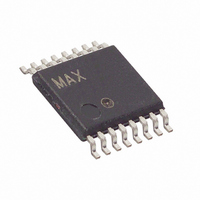MAX1082AEUE+ Maxim Integrated Products, MAX1082AEUE+ Datasheet - Page 20

MAX1082AEUE+
Manufacturer Part Number
MAX1082AEUE+
Description
IC ADC 10BIT 400KSPS 16-TSSOP
Manufacturer
Maxim Integrated Products
Datasheet
1.MAX1082BEUE.pdf
(24 pages)
Specifications of MAX1082AEUE+
Number Of Bits
10
Sampling Rate (per Second)
400k
Data Interface
MICROWIRE™, QSPI™, Serial, SPI™
Number Of Converters
1
Power Dissipation (max)
533mW
Voltage Supply Source
Single Supply
Operating Temperature
-40°C ~ 85°C
Mounting Type
Surface Mount
Package / Case
16-TSSOP
Lead Free Status / RoHS Status
Lead free / RoHS Compliant
300ksps/400ksps, Single-Supply, 4-Channel,
Serial 10-Bit ADCs with Internal Reference
Table 5. Full Scale and Zero Scale
Figure 15. Power-Supply Grounding Connection
Aperture jitter (t
the time between the samples.
Aperture delay (t
rising edge of the sampling clock and the instant when
an actual sample is taken.
For a waveform perfectly reconstructed from digital
samples, the SNR is the ratio of the full-scale analog
input (RMS value) to the RMS quantization error (resid-
ual error). The ideal, theoretical minimum analog-to-dig-
ital noise is caused only by quantization error and
results directly from the ADC’s resolution (N bits):
In reality, there are other noise sources besides quanti-
zation noise, including thermal noise, reference noise,
20
*R = 10Ω
______________________________________________________________________________________
*OPTIONAL
V
+3V
V
DD
REF
Full Scale
+ V
SNR = (6.02 x N + 1.76)dB
AJ
COM
AD
) is the sample-to-sample variation in
MAX1082
MAX1083
GND
GND
Signal-to-Noise Ratio (SNR)
UNIPOLAR MODE
) is the time defined between the
SUPPLIES
COM
V
DD2
Aperture Delay
Aperture Jitter
Zero Scale
V
+3V
+3V
COM
CIRCUITRY
DIGITAL
DGND
clock jitter, etc. Therefore, SNR is calculated by taking
the ratio of the RMS signal to the RMS noise, which
includes all spectral components minus the fundamen-
tal, the first five harmonics, and the DC offset.
SINAD is the ratio of the fundamental input frequency’s
RMS amplitude to RMS equivalent of all other ADC out-
put signals:
ENOB indicates the global accuracy of an ADC at a
specific input frequency and sampling rate. An ideal
ADC’s error consists only of quantization noise. With an
input range equal to the ADC’s full-scale range, calcu-
late ENOB as follows:
THD is the ratio of the RMS sum of the input signal’s
first five harmonics to the fundamental itself. This is
expressed as:
where V
V5 are the amplitudes of the 2nd- through 5th-order
harmonics.
SFDR is the ratio of the RMS amplitude of the funda-
mental (maximum signal component) to the RMS value
of the next-largest distortion component.
Full Scale
V
+ V
Positive
SINAD (dB) = 20 x log (Signal
REF
THD 20 log
Signal-to-Noise Plus Distortion (SINAD)
COM
Spurious-Free Dynamic Range (SFDR)
1
/ 2
=
is the fundamental amplitude, and V
ENOB = (SINAD - 1.76) / 6.02
Effective Number of Bits (ENOB)
Total Harmonic Distortion (THD)
×
BIPOLAR MODE
V
2
Scale
V
Zero
2
COM
+
V
3
2
+
V
V
4
1
RMS
2
+
V
/ Noise
4
Full Scale
Negative
-V
2
+ V
+
REF
V
COM
5
RMS
2
/ 2
2
through
)












